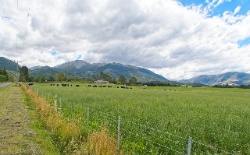Farming for the future with fertiliser science
Farming for the future with fertiliser science
Rollercoaster fertiliser pricing over the past few years has got farmers asking how they can get the biggest bang for their fertiliser buck, and technology could well provide some of the answers.
Although substantially lower than the peak prices of a year ago, fertiliser pricing volatility coupled with uncertainty in farm operating margins will drive farmers towards a more prescriptive, analytical approach to managing their farm system fertiliser requirements, rather than just adding a single fertiliser product at a uniform rate across the whole farm.
‘To get the most out of their spend, farmers will have to be more precise in their application of fertilisers, and they can look forward to new technology providing this capability,’ says Aaron Stafford, Technical Advisor at Ballance Agri-Nutrients.
‘Precision agriculture’ is a buzz phrase in the industry at present, and it is a term that means different things to different people, says Aaron.
‘To some, it may represent IT-heavy data management – for example, the use of geographical information systems (GIS) allowing users to graphically manage and display different layers of farm information in a map-based system.
‘To others, precision agriculture may mean deployment of auto-steer tractors along with GPS guidance and tracking. At the end of the day, precision agriculture is simply about doing what we already do, but doing it better.
‘Along the way, the aim is for farmers to make more money, reduce costs, and reduce exposure of their business to economic, environmental or other threats. Ballance is interested in many different aspects of precision agriculture.’
Aaron says the co-operative is developing internal systems to provide a platform for improved customer service offerings.
‘We have also invested heavily in R&D to support farmers and our field staff in the fertiliser decision-making process, in recognition that farmers of the future will require more site-specific management of nutrients.’
As an example, 2009 marks the final year in an R&D programme to better define nutrient responses and requirements of New Zealand’s largest crop by area sown – forage brassicas.
‘In spring 2010 the outcome will be the release of the turnip and swede calculators, which will complement existing calculators for Pasja and kale, and complete our suite of brassica fertiliser decision support systems.’
These models allow users to quickly access the results from a very wide ranging and comprehensive series of trials, and use this data to determine responsiveness and likely ROI for different nutrients applied to their own situation.
‘No one else in New Zealand has access to the level of trial information that is captured in these models.’
Similarly, Ballance is working on expansion of the Sirius Wheat Calculator. This is a development to allow farmers to use this model for both grain and whole crop silage, as well as for a wider range of cereals such as barley, oats and triticale. The model predicts plant yield and quality parameters, as well as required rate, timing and response to both nitrogen and irrigation inputs.
‘These models are all catering to farmers’ appetite for more advanced solutions to their farming needs.’
Along with models for the pastoral industry such as Overseer, Aaron says this points to a shift in fertiliser ‘standard line product’ purchasing towards more farm or site-specific nutrient recommendations, meaning the fertiliser industry is moving towards a greater number of ‘special mixes’.
‘While this is inevitably good for farming and farmers in that there will be less wastage of unnecessary nutrients, it can create logistic issues for the supplying fertiliser companies, so it is in farmers’ best interest to work closely with our fertiliser reps and plan well in advance.’
ENDS


 Citizens of the Sea: Sailors To Revolutionise Our Understanding Of Pacific Biodiversity
Citizens of the Sea: Sailors To Revolutionise Our Understanding Of Pacific Biodiversity Netsafe: Making A Splash With Online Safety: Netsafe Launches New Flagship Programme For Kids
Netsafe: Making A Splash With Online Safety: Netsafe Launches New Flagship Programme For Kids NZGBC: Flood Resilience PhD Student Widi Auliagisni Named Future Thinker Of The Year 2024
NZGBC: Flood Resilience PhD Student Widi Auliagisni Named Future Thinker Of The Year 2024 Business Canterbury: European Free Trade Agreement A Game-changer For Canterbury
Business Canterbury: European Free Trade Agreement A Game-changer For Canterbury Business Canterbury: Urges Council To Cut Costs, Not Ambition For City
Business Canterbury: Urges Council To Cut Costs, Not Ambition For City Wellington Airport: On Track For Net Zero Emissions By 2028
Wellington Airport: On Track For Net Zero Emissions By 2028



